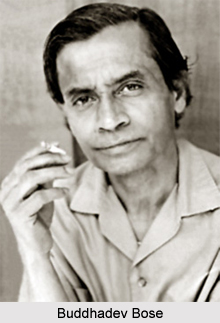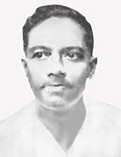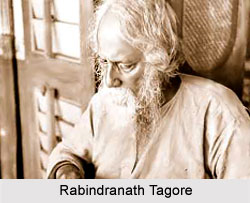 Kallol era in Bengali literature refers to a kind of modernist literary movement which took place sometime if the 1930`s. The decade between the two world wars saw in Bengali literature the rise of an awareness of trends in world literature. Coupled with this was a committed socio-political consciousness among writers in the wake of the first surge of the non-cooperation movement and the disappointment that came after World War I. Perhaps the most important writer during this decade was Kazi Nazrul Islam. Nazrul, although politically committed, was not a scholar-writer who responded to the literary fashions of the Western "modernist" schools. But a host of other writers, most of them belonging to the same generation, did respond to Western "modernism" and started expressing themselves through several journals, engaging in healthy debates on the state of Bengali literature. Given below is a discussion which provides an insight into the journals, poetry and prose of the era.
Kallol era in Bengali literature refers to a kind of modernist literary movement which took place sometime if the 1930`s. The decade between the two world wars saw in Bengali literature the rise of an awareness of trends in world literature. Coupled with this was a committed socio-political consciousness among writers in the wake of the first surge of the non-cooperation movement and the disappointment that came after World War I. Perhaps the most important writer during this decade was Kazi Nazrul Islam. Nazrul, although politically committed, was not a scholar-writer who responded to the literary fashions of the Western "modernist" schools. But a host of other writers, most of them belonging to the same generation, did respond to Western "modernism" and started expressing themselves through several journals, engaging in healthy debates on the state of Bengali literature. Given below is a discussion which provides an insight into the journals, poetry and prose of the era.
Journals of the Kallol era
The culture of writing in journals had developed in Bengali literature right from the nineteenth century, and there was seen the prevalence of a number of journals which served to consolidate the literary products of the period. They always played a major role in Bengali literature when it came to deciding which way the literature was heading. When Kallol (Stormy Current), the literary journal, was founded in 1923 by Gokulchandra Nag (1895-1925) and Dineshranjan Das (1888-1941), Bengali literature was at a crossroads of conflict. This conflict was between the traditionalist camp comprising older writers and the progressive pro-modernist writers consisting of younger writers. The young and unknown writers of Kallol, by their unorthodox literary means and products, earned the anger of the conservative traditionalist camp led by Asok Chattopadhyaya and Sajanikanta Das (1900-62), who replied with their own journal, Sanibarer Chithi (The Saturday Post), founded in 1924. A bitter debate ensued between the progressive and traditional camps, and soon other journals were founded to bolster the Kallol camp. These include Kali O Kalam (Pen and Ink, 1927), edited by Premendra Mitra, Muralidhar Basu, and Sailajananada Mukhopadhyaya from Kolkata, and Nareschandra Sengupta and Buddhadev Bose`s Pragati (Progress, 1928) from Dhaka.
 The debate got so rough that Rabindranath Tagore, the only person respected by both camps, was also drawn into this debate. The main issue now was the direction in which Bengali literature should go. In March 1927, Rabindranath presided over two meetings between the warring camps. He proposed a compromise, but this was not accepted by the progressive camp. More intellectual repartee followed in the literary journals until, finally, Rabindranath silenced all by his formally innovative novel Seser Kabila (1928) and the timely creation of gadya kabita (free prosaic verse, a close approximation of vers libre), which culminated in the collection entitled Parises (The End, 1932).
The debate got so rough that Rabindranath Tagore, the only person respected by both camps, was also drawn into this debate. The main issue now was the direction in which Bengali literature should go. In March 1927, Rabindranath presided over two meetings between the warring camps. He proposed a compromise, but this was not accepted by the progressive camp. More intellectual repartee followed in the literary journals until, finally, Rabindranath silenced all by his formally innovative novel Seser Kabila (1928) and the timely creation of gadya kabita (free prosaic verse, a close approximation of vers libre), which culminated in the collection entitled Parises (The End, 1932).
The influence of the Kallol generation had led to the emergence of three more journals that were destined to have a major impact on Bengali poetry. These are - Sudhindranath Datta`s Parichay (Acquaintance, 1931), Purbasa (Hope of the East), edited by Sanjay Bhattacharya and Buddhadev Bose`s Kabita (Poetry, 1935).
Poetry of Kallol Era
In the field of poetry of the Kallol generation, it has been noted that Jatindranath Sengupta (1887-1958) and Mohitlal Majumdar (1882-1952) were two important poets who consciously tried to be different from Tagore. Amiya Chakrabarti (1901-86) developed under the wings of Rabindranath as his secretary, and traces of Tagorean poetry can be seen in his first collection, Khasra (Rough Draft, 1938). But Chakrabarti eventually developed his own voice, which was heard in his later books, Parapar (Crossovers, 1953) and Palabadal (Change of Time, 1955). Samar Sen (1916-86) was one of the leading figures in the new poetry movement in the Kallol generation who, however, gave up writing poetry altogether but greatly contributed to the development of non-Tagorean Bengali poetry. His two most important collections are Kayekti Kabita (A Few Poems, 1937) and Tinpurus (Three Generations, 1944).
Sudhindranath Datta (1901-60), also the editor of Parichay, was close to Rabindranath in personal life, although his poetry was radically and consciously different from that of the maestro. It was deeply personal, but rich with linguistic inventions in its effort to be free of cliches and hackneyed poetic norms. Datta was not prolific and published only a few, though important, books. His best works include Arkestra (Orchestra, 1935), Uttar-phalguni (The Northerlies, 1940), and Sanbarta (Cataclysmic Clouds, 1953).
 Buddhadev Bose (1908-74) was not only the editor of Kabita, but also a noted poet himself who ventured out into the world of prose, drama, and scholarship with equal ease His best poetical works include Kankabati (1937) and Damayanti (1943). Among his plays the best known is Tapaswi O Tarangini (The Hermit and Tarangini, 1967). He also penned numerous short stories, novels, and scholarly essays on a variety of literary matters.
Buddhadev Bose (1908-74) was not only the editor of Kabita, but also a noted poet himself who ventured out into the world of prose, drama, and scholarship with equal ease His best poetical works include Kankabati (1937) and Damayanti (1943). Among his plays the best known is Tapaswi O Tarangini (The Hermit and Tarangini, 1967). He also penned numerous short stories, novels, and scholarly essays on a variety of literary matters.
Among the other Kallol generation writers, Premendra Mitra (1904-88), who was coeditor of Kali O Kalam, was a literateur of considerable versatility and also worked in the broadcast and film world. His poetry, however, was relatively free of the complexities that marked his modernist compatriots. Among his verse collections are Prathama (The First, 1932), Samrat (The Emperor, 1940), and Sagar Theke Phera (Return from the Sea, 1956).
The most prominent member of the Kallol generation, however, was the poet Jibanananda Das (1899-1954). Though not much recognized in his own lifetime, Jibanananda Das has come to be regarded as probably the most important Bengali poet since Rabindranath. He had started his poetic works with Jhara Palak (Cast-off Feathers, 1928). However he soon severed his ties with traditional Bengali prosody and began to play with different, highly original modes of poetic expression. He experimented with metaphors invoke a rare, mystifying beauty that holds the reader in thrall. Jibanananda`s yearning for a better world lurked wistfully behind the ghastly images he portrayed in his rendition of the contemporary world. It is the same wish for better tidings that made lively his impressionistic pen sketches of Bengal`s natural splendors, which he adored with great passion. Jibanananda Das was a reclusive man and did not publish much, but what he did allow to appear in print comes down to us as, undoubtedly, some of the finest verses ever composed in Indian literature. After Jhara Palak, Jibanananda published only four more collections of poetry: Dhusar Pandulipi (The Faded Manuscript, 1936), Banalata Sen (1942), Mahaprithibi (The Great Earth, 1944), and Satti Tarar Timir (The Darkness of the Seven Stars, 1948).
The most important poet in the period immediately following Jibananda Das is Bishnu De. Technically, both are of the same generation. A professor of English by profession, De freely incorporated his study of Western literature into the mosaic of his poetry. He was heavily inspired by Pound, Yeats, Eliot, and the Greeks, and the sophistication of Bisnu De`s poetry rested mainly on complex imagery and references to obscure worlds and lost civilizations. Among his several volumes of poetry are Urbasi O Artemis (Urbasi and Artemis, 1933), Smriti Satta Bhabisyat (Remembrance, Self, Future, 1963), and Sangbad Mulata Kabya (News Is Essentially Poetry, 1969). His major prose work is a collection of essays on literature, Sahityer Bhabisyat (The Future of Literature, 1952). Most of the poets of the Kallol generation lived on to pursue their careers well into the 1960s and some into the 1970s.
Manindra Ray (1919) is another major poet of the 1940s. His major work is the collection Mohini Aral (The Bewitching Veil, 1967).
Prose of Kallol Era
Not all writers from the Kallol generation were poets. Premendra Mitra, is better known in the Bengali literary circuit as a short story writer, as the creator of the inimitable Ghanada, the Bengali Munchhausen, whose imaginary flights of fancy continue to fascinate both the young and the young-at-heart. Among his notable novels and short story collections are Panchasar (Five Arrows, 1929) and Kuyasa (Mist, 1938). His short story `Janaika Kapuruser Kahini` was made into a short film by Satyajit Ray. Telenapota Abiskar, another of Mitra`s acclaimed short stories, was turned into a successful Hindi feature film, Khandhar, by Mrinal Sen.
Manis Ghatak (1902-79), who wrote under the pseudonym of Jubanasva (Young Horse), was another important member of the Kallol generation, although he did not write much. He is best known for his collection of short stories. This includes Pataldangar Panchali (The Ballads of Pataldanga), which has been identified by scholars as an emblematic document of the literary trend of the age.
Thus, the Kallol era witnessed a modernistic outlook in the world of Bengali literature.



















